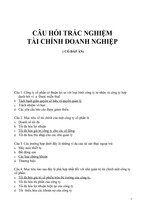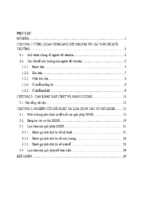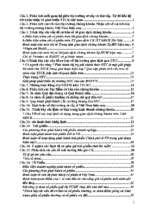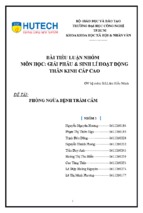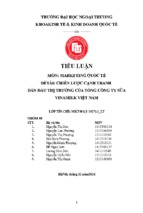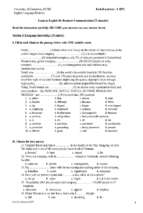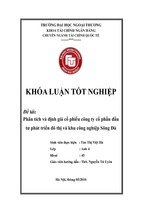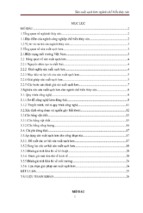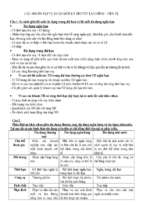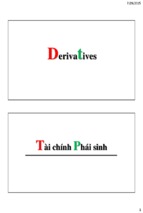Quản lý tài chính doanh nghiệp và đánh giá rủi ro trong các hoạt động tài chính của doanh nghiệp
Do you want to understand how financial decisions impact the value
of a company? If you are new to financial management or studying
for a professional qualification, this user-friendly textbook makes the
challenges facing today’s rapidly changing business world easier to
understand.
Now in its 13th edition, Fundamentals of Financial Management maintains
its dedication to the financial decision-making process and the
analysis of value creation, but develops a more international scope and
introduces new topics into the debate. Current discussions on corporate
governance, ethical dilemmas, globalization of finance, strategic
alliances and the growth of outsourcing have been added with examples
and boxed features to aid understanding and provide a more global
perspective of financial management.
What’s New?
•
Chapter 1 - Expanded coverage of Corporate Social Responsibility
including the concept of Sustainability.
•
Chapter 6 – The discussion of financial statement analysis includes
the push for convergence of accounting standards around the world.
•
Chapter 9 – Cash and marketable securities management material
expanded and updated.
•
Chapter 24 - The updated chapter on International Financial
Management includes discussion of Islamic sukuk bonds.
On the reading list for Association
of Chartered Certified Accountants
(ACCA) Qualification Paper (F9)
Financial Management.
Suggested reading for Certified
Management Accountant (CMA)
examination.
Translated into over ten languages
and received first place among
business academic texts in
Pearson’s top 50 best seller’s
translation list.
“This is the best book I have found so far.”
Jean Bellemans, Free University of Brussels
“The book provides the reader with
information about the current
‘hot-topics’ in finance and has a clear
emphasis on the basic principles of
financial management without repetition.
Furthermore, as simple language is used,
the book can be easily understood by
students that are not native speakers of
English.”
Axel-Adam Müller, Lancaster
Authors:
James C. Van Horne, Professor of Banking and Finance at Stanford University is also the
author of Financial Management and Policy, a Pearson Education text.
Fundamentals of
Financial Management
James C. Van Horne
John M. Wachowicz, Jr.
13th Edition
13th
Edition
Van Horne
Wachowicz
Visit www.pearsoned.co.uk/wachowicz to access free
student resources including:
• Self-test multiple-choice, true/false and essay
questions.
• Link to author’s award-winning website for even more
online testing material, along with exercises and
regularly updated links to additional support material.
• Online glossary to explain key terms.
• Excel templates for spread-sheet approach to
end-of-chapter problem solving.
• New for this edition! Link to PowerPoint slides on
key chapters and learn how to use Excel to solve
problems.
Ideal for introductory courses
in financial management, for a
professional qualification and as
a reference for practitioners.
Fundamentals of Financial Management
“…a useful text either as preparation for a second year course, or as a text for a first year financial
management course that provides a ‘first sweep’ of the major financial management topics. Not many texts
cover this ground well.”
Brian Wright, Exeter
John M. Wachowicz, Jr., Professor of Finance at The University of Tennessee.
an imprint of
CVR_VANH3630_13_SE_CVR.indd 1
Front cover image: © Getty Images
www.pearson-books.com
23/9/08 10:35:34
FUNO_A01.qxd 9/19/08 13:56 Page i
Fundamentals of
Financial Management
Visit the Van Horne and Wachowicz: Fundamentals of Financial Management
thirteenth edition Companion Website at www.pearsoned.co.uk/wachowicz
to find valuable student learning material including:
l
l
l
l
l
l
l
••
Learning objectives for each chapter
Multiple choice, true/false and essay questions to test your understanding
PowerPoint presentations for each chapter to remind you of key concepts
An online glossary to explain key terms and flash cards to test your knowledge
of key terms and definitions in each chapter
Excel templates for end of chapter problems to help you model a spread sheet
approach to solving the problem
Link to author’s own award-winning website with even more multiple choice and
true/false questions, as well as web-based exercises and regularly updated links
to additional support material
New to this edition, PowerPoint presentations for key chapters integrating and
demonstrating how Excel can be used to solve calculations.
FUNO_A01.qxd 9/19/08 13:56 Page ii
We work with leading authors to develop the
strongest educational materials in business and
finance, bringing cutting-edge thinking and best
learning practice to a global market.
Under a range of well-known imprints, including
Financial Times Prentice Hall, we craft high quality
print and electronic publications which help readers
to understand and apply their content, whether
studying or at work.
To find out more about the complete range of our
publishing, please visit us on the World Wide Web at:
www.pearsoned.co.uk
••
FUNO_A01.qxd 9/19/08 13:56 Page iii
Fundamentals of
Financial Management
thirteenth edition
James C. Van Horne
Stanford University
John M. Wachowicz, Jr.
The University of Tennessee
••
FUNO_A01.qxd 4/18/09 10:23 AM Page iv
Pearson Education Limited
Edinburgh Gate
Harlow
Essex CM20 2JE
England
and Associated Companies throughout the world
Visit us on the World Wide Web at:
www.pearsoned.co.uk
Previous editions published under the Prentice Hall imprint
Thirteenth edition published 2008
© Pearson Education Limited 2009, 2005
© 2001, 1998 by Prentice-Hall, Inc.
The rights of James C. Van Horne and John M. Wachowicz, Jr. to be identified as
authors of this work have been asserted by them in accordance with the
Copyright, Designs and Patents Act 1988.
All rights reserved. No part of this publication may be reproduced, stored in a
retrieval system, or transmitted in any form or by any means, electronic,
mechanical, photocopying, recording or otherwise, without either the prior written
permission of the publisher or a licence permitting restricted copying in the United
Kingdom issued by the Copyright Licensing Agency Ltd, Saffron House,
6–10 Kirby Street, London EC1N 8TS.
All trademarks used herein are the property of their respective owners. The use of
any trademark in this text does not vest in the author or publisher any trademark
ownership rights in such trademarks, nor does the use of such trademarks imply
any affiliation with or endorsement of this book by such owners.
ISBN: 978-0-273-71363-0
British Library Cataloguing-in-Publication Data
A catalogue record for this book is available from the British Library
Library of Congress Cataloguing-in-Publication Data
Van Horne, James C.
Fundamentals of financial management / James C. Van Horne, John M. Wachowicz. – 13th ed.
p. cm.
Includes bibliographical references and index.
ISBN 978-0-273-71363-0 (pbk. : alk. paper) 1. Corporations–Finance. 2. Business
enterprises–Finance. I. Wachowicz, John Martin. II. Title.
HG4026.V36 2008
658.15—dc22
2008027365
10 9 8 7 6 5 4 3
12 11 10 09
Typeset in 10/12pt Minion by 35
Printed and bound by Ashford Colour Press Ltd., Gosport
The publisher’s policy is to use paper manufactured from sustainable forests.
••
FUNO_A01.qxd 9/19/08 13:56 Page v
To Mimi, Drew, Stuart, and Stephen
James C. Van Horne
To Emerson, John, June, Lien, and Patricia
John M. Wachowicz, Jr.
••
FUNO_A01.qxd 9/19/08 13:56 Page vi
••
FUNO_A01.qxd 9/19/08 13:56 Page vii
Brief Contents
l l l Part 1 Introduction to Financial Management
1 The Role of Financial Management 1
2 The Business, Tax and Financial Environments 17
l l l Part 2 Valuation
3 The Time Value of Money 41
4 The Valuation of Long-Term Securities 73
5 Risk and Return 97
Appendix A Measuring Portfolio Risk 117
Appendix B Arbitrage Pricing Theory 119
l l l Part 3 Tools of Financial Analysis and Planning
6 Financial Statement Analysis 127
Appendix Deferred Taxes and Financial Analysis 158
7 Funds Analysis, Cash-Flow Analysis, and Financial Planning 169
Appendix Sustainable Growth Modeling 190
l l l Part 4 Working Capital Management
8
9
10
11
Overview of Working Capital Management 205
Cash and Marketable Securities Management 221
Accounts Receivable and Inventory Management 249
Short-Term Financing 281
l l l Part 5 Investment in Capital Assets
12 Capital Budgeting and Estimating Cash Flows 307
13 Capital Budgeting Techniques 323
Appendix A Multiple Internal Rates of Return 341
Appendix B Replacement Chain Analysis 343
14 Risk and Managerial (Real) Options in Capital Budgeting 353
vii
••
FUNO_A01.qxd 9/19/08 13:56 Page viii
Brief Contents
l l l Part 6 The Cost of Capital, Capital Structure,
and Dividend Policy
15 Required Returns and the Cost of Capital 381
Appendix A Adjusting the Beta for Financial Leverage 407
Appendix B Adjusted Present Value 408
16 Operating and Financial Leverage 419
17 Capital Structure Determination 451
18 Dividend Policy 475
l l l Part 7 Intermediate and Long-Term Financing
19 The Capital Market 505
20 Long-Term Debt, Preferred Stock, and Common Stock 527
Appendix Refunding a Bond Issue 544
21 Term Loans and Leases 553
Appendix Accounting Treatment of Leases 567
l l l Part 8 Special Areas of Financial Management
22 Convertibles, Exchangeables, and Warrants 577
Appendix Option Pricing 589
23 Mergers and Other Forms of Corporate Restructuring 603
Appendix Remedies for a Failing Company 630
24 International Financial Management 647
Appendix 679
Glossary 689
Commonly Used Symbols 705
Index 707
viii
••
FUNO_A01.qxd 9/19/08 13:56 Page ix
Contents
Acknowledgements xix
Preface xxi
l l l Part 1 Introduction to Financial Management
1 The Role of Financial Management 1
Objectives 1
Introduction 2
What Is Financial Management? 2
The Goal of the Firm 3
Corporate Governance 8
Organization of the Financial Management Function 8
Organization of the Book 10
Key Learning Points 13
Questions 14
Selected References 14
2 The Business, Tax, and Financial Environments 17
Objectives 17
The Business Environment 18
The Tax Environment 20
The Financial Environment 27
Key Learning Points 35
Questions 36
Self-Correction Problems 37
Problems 37
Solutions to Self-Correction Problems 38
Selected References 39
l l l Part 2 Valuation
3 The Time Value of Money 41
Objectives 41
The Interest Rate 42
Simple Interest 43
Compound Interest 43
Compounding More Than Once a Year 59
Amortizing a Loan 62
Summary Table of Key Compound Interest Formulas 63
Key Learning Points 63
ix
••
FUNO_A01.qxd 9/19/08 13:56 Page x
Contents
Questions 64
Self-Correction Problems 64
Problems 65
Solutions to Self-Correction Problems 69
Selected References 71
4 The Valuation of Long-Term Securities 73
Objectives 73
Distinctions Among Valuation Concepts 74
Bond Valuation 75
Preferred Stock Valuation 78
Common Stock Valuation 79
Rates of Return (or Yields) 83
Summary Table of Key Present Value Formulas for Valuing Long-Term
Securities 88
Key Learning Points 88
Questions 89
Self-Correction Problems 90
Problems 91
Solutions to Self-Correction Problems 93
Selected References 95
5 Risk and Return 97
Objectives 97
Defining Risk and Return 98
Using Probability Distributions to Measure Risk 99
Attitudes Toward Risk 101
Risk and Return in a Portfolio Context 103
Diversification 104
The Capital-Asset Pricing Model (CAPM) 106
Efficient Financial Markets 114
Key Learning Points 116
Appendix A: Measuring Portfolio Risk 117
Appendix B: Arbitrage Pricing Theory 119
Questions 121
Self-Correction Problems 122
Problems 122
Solutions to Self-Correction Problems 125
Selected References 126
l l l Part 3 Tools of Financial Analysis and Planning
6 Financial Statement Analysis 127
Objectives 127
x
••
FUNO_A01.qxd 9/19/08 13:56 Page xi
Contents
Financial Statements 128
A Possible Framework for Analysis 134
Balance Sheet Ratios 138
Income Statement and Income Statement/Balance Sheet Ratios 141
Trend Analysis 152
Common-Size and Index Analysis 153
Key Learning Points 156
Summary of Key Ratios 156
Appendix: Deferred Taxes and Financial Analysis 158
Questions 159
Self-Correction Problems 160
Problems 161
Solutions to Self-Correction Problems 165
Selected References 167
7 Funds Analysis, Cash-Flow Analysis, and Financial Planning 169
Objectives 169
Flow of Funds (Sources and Uses) Statement 170
Accounting Statement of Cash Flows 176
Cash-Flow Forecasting 180
Range of Cash-Flow Estimates 184
Forecasting Financial Statements 186
Key Learning Points 190
Appendix: Sustainable Growth Modeling 190
Questions 194
Self-Correction Problems 195
Problems 197
Solutions to Self-Correction Problems 200
Selected References 203
l l l Part 4 Working Capital Management
8 Overview of Working Capital Management 205
Objectives 205
Introduction 206
Working Capital Issues 208
Financing Current Assets: Short-Term and Long-Term Mix 210
Combining Liability Structure and Current Asset Decisions 215
Key Learning Points 216
Questions 216
Self-Correction Problem 217
Problems 217
Solutions to Self-Correction Problem 218
Selected References 219
xi
••
FUNO_A01.qxd 9/19/08 13:56 Page xii
Contents
9 Cash and Marketable Securities Management 221
Objectives 221
Motives for Holding Cash 222
Speeding Up Cash Receipts 223
S-l-o-w-i-n-g D-o-w-n Cash Payouts 228
Electronic Commerce 231
Outsourcing 233
Cash Balances to Maintain 234
Investment in Marketable Securities 235
Key Learning Points 244
Questions 245
Self-Correction Problems 245
Problems 246
Solutions to Self-Correction Problems 247
Selected References 248
10 Accounts Receivable and Inventory Management 249
Objectives 249
Credit and Collection Policies 250
Analyzing the Credit Applicant 258
Inventory Management and Control 263
Key Learning Points 273
Questions 274
Self-Correction Problems 274
Problems 275
Solutions to Self-Correction Problems 278
Selected References 279
11 Short-Term Financing 281
Objectives 281
Spontaneous Financing 282
Negotiated Financing 287
Factoring Accounts Receivable 298
Composition of Short-Term Financing 300
Key Learning Points 301
Questions 302
Self-Correction Problems 302
Problems 303
Solutions to Self-Correction Problems 305
Selected References 306
l l l Part 5 Investment in Capital Assets
12 Capital Budgeting and Estimating Cash Flows 307
Objectives 307
The Capital Budgeting Process: An Overview 308
xii
••
FUNO_A01.qxd 9/19/08 13:56 Page xiii
Contents
Generating Investment Project Proposals 308
Estimating Project “After-Tax Incremental Operating Cash Flows” 309
Key Learning Points 318
Questions 318
Self-Correction Problems 319
Problems 319
Solutions to Self-Correction Problems 321
Selected References 322
13 Capital Budgeting Techniques 323
Objectives 323
Project Evaluation and Selection: Alternative Methods 324
Potential Difficulties 330
Project Monitoring: Progress Reviews and Post-Completion Audits 340
Key Learning Points 340
Appendix A: Multiple Internal Rates of Return 341
Appendix B: Replacement Chain Analysis 343
Questions 345
Self-Correction Problems 346
Problems 347
Solutions to Self-Correction Problems 349
Selected References 350
14 Risk and Managerial (Real) Options in Capital Budgeting 353
Objectives 353
The Problem of Project Risk 354
Total Project Risk 357
Contribution to Total Firm Risk: Firm-Portfolio Approach 364
Managerial (Real) Options 368
Key Learning Points 373
Questions 373
Self-Correction Problems 374
Problems 375
Solutions to Self-Correction Problems 377
Selected References 379
l l l Part 6 The Cost of Capital, Capital Structure, and Dividend Policy
15 Required Returns and the Cost of Capital 381
Objectives 381
Creation of Value 382
Overall Cost of Capital of the Firm 383
The CAPM: Project-Specific and Group-Specific Required Rates of Return 396
Evaluation of Projects on the Basis of Their Total Risk 401
Key Learning Points 406
xiii
••
FUNO_A01.qxd 9/19/08 13:56 Page xiv
Contents
Appendix A: Adjusting the Beta for Financial Leverage 407
Appendix B: Adjusted Present Value 408
Questions 410
Self-Correction Problems 411
Problems 412
Solutions to Self-Correction Problems 415
Selected References 417
16 Operating and Financial Leverage 419
Objectives 419
Operating Leverage 420
Financial Leverage 427
Total Leverage 435
Cash-Flow Ability to Service Debt 436
Other Methods of Analysis 439
Combination of Methods 440
Key Learning Points 441
Questions 442
Self-Correction Problems 443
Problems 444
Solutions to Self-Correction Problems 446
Selected References 449
17 Capital Structure Determination 451
Objectives 451
A Conceptual Look 452
The Total-Value Principle 456
Presence of Market Imperfections and Incentive Issues 458
The Effect of Taxes 461
Taxes and Market Imperfections Combined 463
Financial Signaling 465
Timing and Financial Flexibility 465
Financing Checklist 466
Key Learning Points 467
Questions 468
Self-Correction Problems 468
Problems 469
Solutions to Self-Correction Problems 471
Selected References 473
18 Dividend Policy 475
Objectives 475
Passive versus Active Dividend Policies 476
Factors Influencing Dividend Policy 481
Dividend Stability 484
xiv
••
FUNO_A01.qxd 9/19/08 13:56 Page xv
Contents
Stock Dividends and Stock Splits 486
Stock Repurchase 491
Administrative Considerations 495
Key Learning Points 496
Questions 497
Self-Correction Problems 498
Problems 499
Solutions to Self-Correction Problems 501
Selected References 502
l l l Part 7 Intermediate and Long-Term Financing
19 The Capital Market 505
Objectives 505
Déjà Vu All Over Again 506
Public Issue 507
Privileged Subscription 509
Regulation of Security Offerings 512
Private Placement 516
Initial Financing 519
Signaling Effects 520
The Secondary Market 522
Key Learning Points 522
Questions 523
Self-Correction Problems 524
Problems 524
Solutions to Self-Correction Problems 525
Selected References 526
20 Long-Term Debt, Preferred Stock, and Common Stock 527
Objectives 527
Bonds and Their Features 528
Types of Long-Term Debt Instruments 529
Retirement of Bonds 532
Preferred Stock and Its Features 534
Common Stock and Its Features 538
Rights of Common Shareholders 539
Dual-Class Common Stock 542
Key Learning Points 543
Appendix: Refunding a Bond Issue 544
Questions 546
Self-Correction Problems 547
Problems 548
Solutions to Self-Correction Problems 550
Selected References 551
xv
••
FUNO_A01.qxd 9/19/08 13:56 Page xvi
Contents
21 Term Loans and Leases 553
Objectives 553
Term Loans 554
Provisions of Loan Agreements 556
Equipment Financing 558
Lease Financing 559
Evaluating Lease Financing in Relation to Debt Financing 562
Key Learning Points 567
Appendix: Accounting Treatment of Leases 567
Questions 570
Self-Correction Problems 571
Problems 572
Solutions to Self-Correction Problems 573
Selected References 575
l l l Part 8 Special Areas of Financial Management
22 Convertibles, Exchangeables, and Warrants 577
Objectives 577
Convertible Securities 578
Value of Convertible Securities 581
Exchangeable Bonds 584
Warrants 585
Key Learning Points 589
Appendix: Option Pricing 589
Questions 595
Self-Correction Problems 596
Problems 597
Solutions to Self-Correction Problems 599
Selected References 600
23 Mergers and Other Forms of Corporate Restructuring 603
Objectives 603
Sources of Value 604
Strategic Acquisitions Involving Common Stock 608
Acquisitions and Capital Budgeting 615
Closing the Deal 617
Takeovers, Tender Offers, and Defenses 620
Strategic Alliances 622
Divestiture 623
Ownership Restructuring 626
Leveraged Buyouts 627
Key Learning Points 629
Appendix: Remedies for a Failing Company 630
Questions 635
Self-Correction Problems 636
Problems 638
xvi
••
FUNO_A01.qxd 9/19/08 13:56 Page xvii
Contents
Solutions to Self-Correction Problems 641
Selected References 643
24 International Financial Management 647
Objectives 647
Some Background 648
Types of Exchange-Rate Risk Exposure 652
Management of Exchange-Rate Risk Exposure 656
Structuring International Trade Transactions 668
Key Learning Points 671
Questions 672
Self-Correction Problems 673
Problems 674
Solutions to Self-Correction Problems 676
Selected References 677
Appendix 679
Table I:
Table II:
Table III:
Table IV:
Table V:
Future value interest factor 680
Present value interest factor 682
Future value interest factor of an (ordinary) annuity 684
Present value interest factor of an (ordinary) annuity 686
Area of normal distribution that is Z standard deviations
to the left or right of the mean 688
Glossary 689
Commonly Used Symbols 705
Index 707
xvii
••
FUNO_A01.qxd 9/19/08 13:56 Page xviii
Supporting resources
Visit www.pearsoned.co.uk/wachowicz to find valuable online resources
Companion Website for students
l Learning objectives for each chapter
l Multiple choice, true/false and essay questions to test your understanding
l PowerPoint presentations for each chapter to remind you of key concepts
l An online glossary to explain key terms and flash cards to test your knowledge of key terms and
definitions in each chapter
l Excel templates for end of chapter problems to help you model a spread sheet approach to solving
the problem
l Link to author’s own award-winning website with even more multiple choice and true/false
questions, as well as web-based exercises and regularly updated links to additional support
material
l New to this edition, PowerPoint presentations for each chapter integrating and demonstrating how
Excel can be used to help solve calculations.
For instructors
l Extensive Instructor’s Manual including answers to questions, solutions to problems and solutions
to self-correction problems
l PowerPoint slides plus PDF’s of all figures and tables from the book
l Testbank of additional question material.
Also: The Companion Website provides the following features:
l Search tool to help locate specific items of content
l E-mail results and profile tools to send results of quizzes to instructors
l Online help and support to assist with website usage and troubleshooting.
For more information please contact your local Pearson Education representative
or visit www.pearsoned.co.uk/wachowicz
••
FUNO_A01.qxd 9/19/08 13:56 Page xix
Acknowledgements
We would like to express our gratitude to the following academics, as well as additional
anonymous reviewers, who provided invaluable feedback on this book during the development of the thirteenth edition:
Dr Brian Wright, at Exeter University
Dr Axel F.A. Adam-Muller, at Lancaster University
Dr Graham Sadler, at Aston University
We are grateful to the following for permission to reproduce copyright material:
Figure 10.3 D&B Composite Rating from a Reference Book and a Key to Ratings, 2003.
Reprinted by permission, Dun & Bradstreet, 2007; Cartoon on page 272 from “What is
needed to make a ‘just-in-time’ system work,” Iron Age Magazine, June 7, 1982. Reprinted by
permission, Iron Age.
Anheuser-Busch Companies, Inc., for permission to reproduce their logo and an extract
from the 2006 Annual Report, p. 36. Copyright © 2006 Anheuser-Busch Companies Inc. Used
by permission. All rights reserved; BP p. l.c, for permission to reproduce an extract from the
BP Annual Report 2006, p. 27. Copyright © 2006 BP p. l.c. Used by permission. All rights
reserved; Cameco Corporation, for permission to reproduce their logo and an extract from
the Cameco Corporation Annual Report 2006 (www.cameco.com/investor_relations/annual/
2006/html/mda/fuel_services.php). Copyright © 2006 Cameco Corporation. Used by permission. All rights reserved; CCH Incorporated for permission to reproduce their logo and
extracts adapted from “Ask Alice about Ethics” and “Ask Alice about Accountants”, reproduced from www.toolkit.cch.com. Reproduced with permission from CCH Business Owner’s
Toolkit, published and copyrighted by CCH Incorporated; CFO Publishing Corporation for
permission to reproduce the CFO Asia logo and extracts reproduced from “Virtue Rewarded,”
CFO Asia, O’Sullivan K., (November 2006), pp. 58–63 and “One Continent, One Payment
System,” CFO Asia (April 2007), p. 41, www.cfoasia.com. Copyright © 2007 CFO Publishing
Corporation. Used by permission. All rights reserved; CFO Publishing Corporation for permission to reproduce the CFO logo and extracts adapted from “A Trade Secret Comes to
Light, Again,” CFO, by Leone M., November 2005, pp. 97–99. “Four Eyes are Better,” CFO, by
O’Sullivan K., June 2006, p. 21; “More Rules, Higher Profits,” CFO, Durfee D., August 2006,
p. 24 and “Buy it Back, And Then?” CFO, Durfee D., September 2006, p. 22, www.cfo.com.
Copyright © 2006 CFO Publishing Corporation. Used by permission. All rights reserved; The
Coca-Cola Company for extracts from their Annual Report, 2006 (Form 10-k) pp. 59 and 65,
and permission to reproduce their registered trademarks: Coca-Cola and the Contour Bottle.
Coca-Cola and the Contour Bottle are registered trademarks of The Coca-Cola Company;
Crain Communications Inc., for permission to reproduce the Financial Week logo and adapt
extracts from: “Shell Game Grows as an Exit Strategy,” Financial Week, by Byrt F., January 15
2007, pp. 3 and 18; “New Leasing Rules Could Hammer Corporate Returns,” Financial Week,
by Scott M., April 2 2007; “Spin-Off Frenzy Sets New Record,” Financial Week, by Byrt F.,
April 9 2007, pp. 3 and 21 and “A Bent for Cash. Literally,” Financial Week, by Johnston M.,
July 23 2007, p. 10, www.financialweek.com. Copyright © 2007 by Crain Communications
Inc. Used by permission. All rights reserved; Cygnus Business Media for permission to reproduce its Supply & Demand Chain Executive logo and an extract from “More than $1 Trillion
Seen Unnecessarily Tied Up in Working Capital,” Supply & Demand Chain Executive,
June/July 2006, p. 10, www.sdcexec.com Copyright © 2006 Cygnus Business Media. Used by
permission. All rights reserved; Debra Yergen for permission to adapt an extract from “The
Check’s in the Box,” Canadian National Treasurer, by Yergen D., December 2005/January
xix
••
- Xem thêm -


